Chiapas – Mexicos Colorful South
(16th May – 1st June 2016)
The unbearable heat continued as we finally crossed the border into the state of Chiapas, which we had heard about often even before entering Mexico. It’s beauty, nature, indigenous peoples, and the infamous Zapatistas – freedom fighters which are still active in the region. We were quite excited and somewhat nervous to finally be there and as it turned out we had good reason to be.
A Noisy Spectacle
Our first stop in Chiapas was the “Sima de las Cotorras” an almost alien hole in the ground which was used by … parrots as their nesting grounds. Our route took us past an Oxxo – a type of 7-Eleven that can be found throughout Mexico – one of the only places where we could almost be guaranteed to find Magnum ice-cream. Mexican-made ice-cream was like our experience with the food – finding something really good was hit or miss, but mostly miss. So, at some point we gave up trying after a few rather disappointing experiences. With Magnum, however, you know what you are getting and in the glowing heat of the day it was not only a magnificent taste sensation, but it was a welcome relief from the blistering heat, which gave us the perfect excuse to stop at just about every Oxxo we passed to pick up a Magnum. Although our camping spot at “Sima de las Cotorras” was only a couple of hundred meters higher than our previous camp, the altitude change made a difference in the temperature. The nights cooled a little even though it was still blisteringly hot during the day. We were also quite happy to discover that the campground had cold showers available and so we took advantage of them just after arriving and once again just before going to bed, what a treat! In the evening we took a walk around the impressive crater, accompanied the entire way by the strange call of the local cicadas. The real spectacle, however, would start just after sunrise. Thousands of mating pairs of the bright green parrots take to the air in search of food. A deafening and fascinating display! The chattering parrots circled the crater in a flock of distinct pairs a few times, perhaps taking a break in a nearby tree before they finally flew over our heads and into the distance. The whole thing took about an hour or so before quietening down leaving only the nesting birds behind. The experience left us with an appetite for our own breakfast after which we took another cold shower before heading out once again into the hellish heat of the lowlands.
The Sumidero Canyon
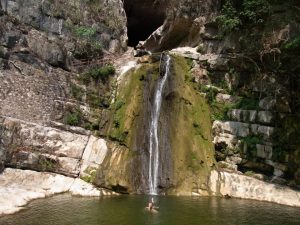 The morning was spent driving and eating Magnum ice-cream before we finally reached the capital city of Chiapas, Tuxtla Gutierrez. It felt even hotter than we had thus far experienced and almost decided to continue onward to the cool 2000-meter heights of Mexico’s southern highlands without stopping. Though, there was an attraction that we just didn’t want to miss – the Sumidero Canyon. Quite a few Mexicans told us that we should under no circumstances miss it, and with so many locals praising the canyon we couldn’t just pass it by. There are boat tours at various times during the day that take one though the canyon, but the first one in the morning was the one we wanted. The hope was that the temperature should be somewhat bearable in the early morning. Until then we had to somehow withstand the incredible afternoon heat without going crazy. Thankfully, there was a natural swimming pool not far away that was fed by a river passing through a tunnel in the mountainside and was therefore blessedly cool. The sun beat down so hard that it almost made us dizzy, so we tried to walk on the path, where possible only in the shade and once reaching the pools jumped into the cooling waters along with all the locals. Finally, cooled down to almost normal, we could tolerate the heat for a few hours at least until we left our little oasis to head back to the canyon. The tourist center let us camp for free in their parking lot under huge shade giving mango trees. But, If we thought we would have a good night sleep we were very mistaken – lethargic, appetite less and dripping with sweat we sat around hoping in vain for a little breeze or perhaps by some magic the temperature would drop a degree or two. At one point we asked ourselves how the advice of all the travel doctors and brochures that we read before our trip were to be followed in this absurd heat. Their opinion, or advice, states that when one is in the tropics one should always wear light colored long sleeved shirts and long pants and of course be sprayed with repellent to avoid getting any mosquito bites. They also suggested that one be familiar with what the distinct types of mosquitos look like, especially the Tiger mosquito which is the main carrier of all the nasty tropical diseases. So far so good and it all makes sense, in theory. Though honestly, we would really like to know if any of the travel doctors had ever had to live 24hrs outside in these conditions, we somehow doubt it, especially wearing the suggested amount of clothing when we can barely survive half naked! As to the repellent theory it also looks much different in reality. Sure, we have high-grade DEET with us, but discovered that we would practically have to shower us with it to be certain that every available patch of exposed skin is covered. As soon as the smallest of bits remains uncovered you can be guaranteed that a mosquito will find it. Zicka, Chikungunya and Dengue are all spread by the Tiger mosquito and from here out one can even get Malaria – none of which anyone wants to contract. However, our conclusion based on personal experience is that you will get bitten when you live outside, no two ways about it, irrespective of any counter measures you may take to try and avoid it. In the beginning we worried endlessly about being bitten, but to avoid making ourselves crazy we decided after a relatively short period of time try go more “native” – they simply live with the fact that the diseases exist and don’t worry about what might happen. We did our best to protect ourselves with what we had. So, we put long pants on, covered ourselves in DEET, burnt a repellent spiral and still the unbelievably fast bloodthirsty tiger mosquitos circled around us waiting for their chance to strike.
The morning was spent driving and eating Magnum ice-cream before we finally reached the capital city of Chiapas, Tuxtla Gutierrez. It felt even hotter than we had thus far experienced and almost decided to continue onward to the cool 2000-meter heights of Mexico’s southern highlands without stopping. Though, there was an attraction that we just didn’t want to miss – the Sumidero Canyon. Quite a few Mexicans told us that we should under no circumstances miss it, and with so many locals praising the canyon we couldn’t just pass it by. There are boat tours at various times during the day that take one though the canyon, but the first one in the morning was the one we wanted. The hope was that the temperature should be somewhat bearable in the early morning. Until then we had to somehow withstand the incredible afternoon heat without going crazy. Thankfully, there was a natural swimming pool not far away that was fed by a river passing through a tunnel in the mountainside and was therefore blessedly cool. The sun beat down so hard that it almost made us dizzy, so we tried to walk on the path, where possible only in the shade and once reaching the pools jumped into the cooling waters along with all the locals. Finally, cooled down to almost normal, we could tolerate the heat for a few hours at least until we left our little oasis to head back to the canyon. The tourist center let us camp for free in their parking lot under huge shade giving mango trees. But, If we thought we would have a good night sleep we were very mistaken – lethargic, appetite less and dripping with sweat we sat around hoping in vain for a little breeze or perhaps by some magic the temperature would drop a degree or two. At one point we asked ourselves how the advice of all the travel doctors and brochures that we read before our trip were to be followed in this absurd heat. Their opinion, or advice, states that when one is in the tropics one should always wear light colored long sleeved shirts and long pants and of course be sprayed with repellent to avoid getting any mosquito bites. They also suggested that one be familiar with what the distinct types of mosquitos look like, especially the Tiger mosquito which is the main carrier of all the nasty tropical diseases. So far so good and it all makes sense, in theory. Though honestly, we would really like to know if any of the travel doctors had ever had to live 24hrs outside in these conditions, we somehow doubt it, especially wearing the suggested amount of clothing when we can barely survive half naked! As to the repellent theory it also looks much different in reality. Sure, we have high-grade DEET with us, but discovered that we would practically have to shower us with it to be certain that every available patch of exposed skin is covered. As soon as the smallest of bits remains uncovered you can be guaranteed that a mosquito will find it. Zicka, Chikungunya and Dengue are all spread by the Tiger mosquito and from here out one can even get Malaria – none of which anyone wants to contract. However, our conclusion based on personal experience is that you will get bitten when you live outside, no two ways about it, irrespective of any counter measures you may take to try and avoid it. In the beginning we worried endlessly about being bitten, but to avoid making ourselves crazy we decided after a relatively short period of time try go more “native” – they simply live with the fact that the diseases exist and don’t worry about what might happen. We did our best to protect ourselves with what we had. So, we put long pants on, covered ourselves in DEET, burnt a repellent spiral and still the unbelievably fast bloodthirsty tiger mosquitos circled around us waiting for their chance to strike.
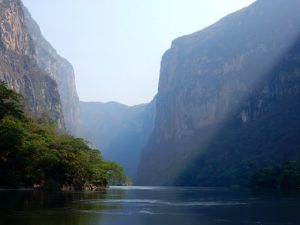 The temperature that night did in fact drop one or two degrees just before sunrise and we were that much happier that we decided to take the first boat in the coolest hours of the day. Together with a hoard of typically joyful Mexicans we headed out into the impressive canyon, happy that we didn’t decided to continue on the day before and miss this remarkable sight. Incredibly huge 1000-meter shear walls rose out of the water to our left and right. The river snaked along through the narrow gorge and a tropical paradise grew along the narrow banks. A brief time later we encountered a troop of spider monkeys along with their young hanging about in the trees that grow along the banks and up the steep cliffs. Our guide pointed out a crocodile sunning itself on a large rock before we got too close and it slipped silently into the water. The tour took about an hour before we exited the canyon into a large man-made lake. At the end of said lake waited something for us that we absolutely didn’t expect, a boat, that for all intents and purposes was a floating convenience store! In case we hadn’t mentioned it yet it’s pretty typical for Mexico that you can buy food just about everywhere, it doesn’t matter how remote you will find a snack stand or at the very least there will be someone there with a cooler filled with Coca-Cola, sliced fruit, Quesadillas or something similar. Although used to it by now, we were nevertheless somewhat surprised to find it there. Though, in retrospect, we shouldn’t have been since we were half way through a 2-hour tour, what a better place to sell to a captive audience. If it wasn’t clear before it was now settled: It is impossible to go hungry in Mexico! Our Mexican colleagues on the boat were naturally not surprised to encounter the floating salesman and loaded up on bags of sliced mango, chips, cola and even beer before we headed back one Mexican experience richer.
The temperature that night did in fact drop one or two degrees just before sunrise and we were that much happier that we decided to take the first boat in the coolest hours of the day. Together with a hoard of typically joyful Mexicans we headed out into the impressive canyon, happy that we didn’t decided to continue on the day before and miss this remarkable sight. Incredibly huge 1000-meter shear walls rose out of the water to our left and right. The river snaked along through the narrow gorge and a tropical paradise grew along the narrow banks. A brief time later we encountered a troop of spider monkeys along with their young hanging about in the trees that grow along the banks and up the steep cliffs. Our guide pointed out a crocodile sunning itself on a large rock before we got too close and it slipped silently into the water. The tour took about an hour before we exited the canyon into a large man-made lake. At the end of said lake waited something for us that we absolutely didn’t expect, a boat, that for all intents and purposes was a floating convenience store! In case we hadn’t mentioned it yet it’s pretty typical for Mexico that you can buy food just about everywhere, it doesn’t matter how remote you will find a snack stand or at the very least there will be someone there with a cooler filled with Coca-Cola, sliced fruit, Quesadillas or something similar. Although used to it by now, we were nevertheless somewhat surprised to find it there. Though, in retrospect, we shouldn’t have been since we were half way through a 2-hour tour, what a better place to sell to a captive audience. If it wasn’t clear before it was now settled: It is impossible to go hungry in Mexico! Our Mexican colleagues on the boat were naturally not surprised to encounter the floating salesman and loaded up on bags of sliced mango, chips, cola and even beer before we headed back one Mexican experience richer.
San Cristóbal de las Casas
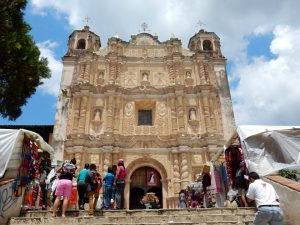 Happy to have visited the canyon we were never the less ready to leave the lowlands as quickly as possible and flee the unbearable heat. The road curved its way slowly upward for a while before it started to get cooler, or more correctly less unbearable. Finally, the wind coming through the open windows was cool! What a great feeling it was to breath deep of the fresh cool air; by the time we reached 2000 meters it seemed almost cold to us in comparison to the hellish heat of the lowlands – despite the fact that the temperatures were still well over 20 degrees. On the way to San Cristobal it wasn’t only the landscape and temperature that changed but the entire picture. Suddenly, we saw a lot more indigenous faces with the women in their colorful traditional costumes and men driving decorated pickups. At the many stands and shops along the side of the road the fruits and vegetables were artfully arranged in piles or in colorful little buckets and baskets making it irresistible so that before we actually reached the town the Landy was filled with fresh regional stuff. As cultural capital of Chiapas San Cristobal is a lovely colonially styled town and a sort of melting pot of cultures. Although colonial it is mostly known as the stronghold of the EZLN or more commonly known Zapatists – an indigenous freedom fighter group with a very unique history. Without going into too much detail (there are enough books, articles, films, and such to be found online) I can say that we were moved by their story. There are many galleries with Zapatist art and literature and the EZLN flag can be seen throughout the town. What impressed me the most about the EZLN is how many of their number are made up of women and how much equality there is between men and women – 1/3rd of the troops is made up entirely of women and are treated completely equal. A theme that is evident in their art as well with mask wearing women carrying mask wearing babies on their backs. As we walked through the town it was even more clear to us how important San Cristobal is for the EZLN – even a statue of Mary Magdalena was clothed and masked like a Zapatist. We spent the entire afternoon going from one art gallery to the next learning about their story, however, San Cristobal is not only the stronghold of the Zapatists. Being a colonial town, it is filled with wonderful streets and lanes and is a magnet for tourists of the world. Bohemian cafes and restaurants fill the town and it even has a bit of a hippy/alternative undercurrent. Despite all the western influences, in a different part of town you can find your typical Mexican market with everything one could want, Tiendas, street vendors and the pulsing overflowing streets we have come to know so well. It was simply fun to explore the different neighborhoods and wander through all the chaos; buy fresh fruits and veggies and later go to one of the many cafes lining the plaza. Unlike the rest of Mexico San Cristobal had some culinary highlights in store for us too. Our favorite discovery was the “Horno Magico” (Magic Oven) – a French run bakery with the best bread in the whole of Mexico, not to forget all the awesome pastries as well like the pudding roll and chocolate croissants…pure magic!
Happy to have visited the canyon we were never the less ready to leave the lowlands as quickly as possible and flee the unbearable heat. The road curved its way slowly upward for a while before it started to get cooler, or more correctly less unbearable. Finally, the wind coming through the open windows was cool! What a great feeling it was to breath deep of the fresh cool air; by the time we reached 2000 meters it seemed almost cold to us in comparison to the hellish heat of the lowlands – despite the fact that the temperatures were still well over 20 degrees. On the way to San Cristobal it wasn’t only the landscape and temperature that changed but the entire picture. Suddenly, we saw a lot more indigenous faces with the women in their colorful traditional costumes and men driving decorated pickups. At the many stands and shops along the side of the road the fruits and vegetables were artfully arranged in piles or in colorful little buckets and baskets making it irresistible so that before we actually reached the town the Landy was filled with fresh regional stuff. As cultural capital of Chiapas San Cristobal is a lovely colonially styled town and a sort of melting pot of cultures. Although colonial it is mostly known as the stronghold of the EZLN or more commonly known Zapatists – an indigenous freedom fighter group with a very unique history. Without going into too much detail (there are enough books, articles, films, and such to be found online) I can say that we were moved by their story. There are many galleries with Zapatist art and literature and the EZLN flag can be seen throughout the town. What impressed me the most about the EZLN is how many of their number are made up of women and how much equality there is between men and women – 1/3rd of the troops is made up entirely of women and are treated completely equal. A theme that is evident in their art as well with mask wearing women carrying mask wearing babies on their backs. As we walked through the town it was even more clear to us how important San Cristobal is for the EZLN – even a statue of Mary Magdalena was clothed and masked like a Zapatist. We spent the entire afternoon going from one art gallery to the next learning about their story, however, San Cristobal is not only the stronghold of the Zapatists. Being a colonial town, it is filled with wonderful streets and lanes and is a magnet for tourists of the world. Bohemian cafes and restaurants fill the town and it even has a bit of a hippy/alternative undercurrent. Despite all the western influences, in a different part of town you can find your typical Mexican market with everything one could want, Tiendas, street vendors and the pulsing overflowing streets we have come to know so well. It was simply fun to explore the different neighborhoods and wander through all the chaos; buy fresh fruits and veggies and later go to one of the many cafes lining the plaza. Unlike the rest of Mexico San Cristobal had some culinary highlights in store for us too. Our favorite discovery was the “Horno Magico” (Magic Oven) – a French run bakery with the best bread in the whole of Mexico, not to forget all the awesome pastries as well like the pudding roll and chocolate croissants…pure magic!
There was something else that we noticed and that was how the mothers treated their babies and young children – more correctly how they breast fed them. Most of the local population in San Cristobal is indigenous and so you see mostly traditionally clothed women in the markets and streets selling their wares. Almost every woman has at least one young child and is most probably also carrying a baby on her back in the traditional way – wrapping in a shawl of sorts. Breast feeding babies and young children in public is totally natural here, it is nothing to be ashamed of or have the feeling that one should hide away while doing it. It is simply part of ordinary life and it is typical to see a woman breastfeeding at her market stand or in the street. One situation which drove home the point was when we were sitting in a café a woman selling bracelets came by our table – one breast exposed and in her arm her child who had just fallen asleep while suckling.
Just on the outskirts of town we found a comfortable campground, that not only had exceptional showers but something which we hadn’t really seen in the entire country – quiet hours! We almost didn’t believe it and were so excited. Interesting how things change: If we had seen something like that in Germany we would have complained about how anal and stiff the place was, but after almost 3 months of constant noise we were thankful for a few nights relatively uninterrupted sleep. The only thing that was missing was some pleasant company we thought. After so long to meet some like-minded travelers would be nice. Though, as we arrived at the campground the only thing we noticed was a huge old Hymer RV with UK plates and we had very little hope of finding anybody of similar mindset in that old-timer. Needless to say, we were really surprised when instead of two gray haired, narrow minded – stiff upper lip – types Mark and Saskia exited the RV. They were in our age range and simply good people whom we immediately got along with. It was clear to us that we would be spending time together and we did just that; chatting for hours, joint excursions into San Cristobal, cooking together and playing board games.
It seemed that we also arrived just in time for the yearly intercultural festival, which included traditional dances and food. Taking advantage of the goings on we strolled into town to watch the festivities, though one needs to be careful where one sits during such events. If for example you sit in the first row like we did it could easily happen that you may well be pulled onto your feet by one of the costumed people for a turn on the dance floor. Apparently, our skin tone was so obvious in the crowd of locals that it soon made it to the MC that a couple of Germans were enjoying the festival, that we were introduced to all and given gifts in welcome of straw hats and traditional sweet pastries! Yet another unforgettable Mexican experience.
With our arrival in San Cristobal something happened that we hadn’t experienced in several months: It rained. On our first day we noticed dark clouds in the afternoon and suddenly the sky opened; it poured down in buckets accompanied by thunder and lighting. Within a brief time, the streets turned into rivers and the rain drummed against the tin roofs. People ran about trying to find shelter from the downpour. It ended just as suddenly as it started, and we asked ourselves after so long underway in almost drought like conditions if this could be the start of the rainy season. Nah, it couldn’t be it’s only the beginning of May, right? Unfortunately, the locals informed us that indeed it was the beginning of the rainy season. The rainy season, which we intended to avoid like the plague especially after all the horror stories we had heard. Well that’s the difference between planning and reality. Now we would definitely be driving through central America in the middle of it and this was just the beginning…
Chickens and Churches
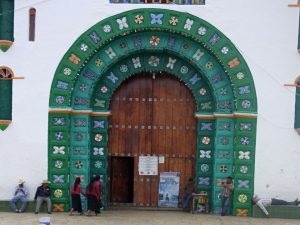 If you visit San Cristobal you can’t miss the church of San Juan Chamula, which unfortunately has become a standard tourist attraction with entrance fee and over priced parking. However, the village continues to live out its mystical traditions. The former Catholic church has been transformed into something of a fusion of Christianity and indigenous beliefs where some very strange practices are preformed, like for example the sacrificial offering of chickens. Yes, you heard right, we didn’t believe either, but as we understood it the locals take a chicken into the church and pray that all the bad things or demons transfer from them into the chicken and then they sacrifice the animal. At first, we thought it was just a rumor designed to attract tourists but were curious enough to drive up to the village of Chamula to take a look for ourselves. As we entered the church we were astounded to see all the Catholic relics and statues lining the walls. Instead of benches or pews, however, the floor was cleared free and covered with pine needles, which gave a wonderful scent in comparison to standard incense, and hundreds of burning candles. Indigenous folk sat here and there on the floor praying alone or in groups and yes lots of them had a chicken in their lap! What happened to the chickens we didn’t really want to know but we were nevertheless fascinated by the mystical atmosphere. It was an interesting experience to immerse ourselves for a moment into a completely different world, and as we strolled through the regional market we passed a section selling live chickens; it was once again made clear to us exactly where we were.
If you visit San Cristobal you can’t miss the church of San Juan Chamula, which unfortunately has become a standard tourist attraction with entrance fee and over priced parking. However, the village continues to live out its mystical traditions. The former Catholic church has been transformed into something of a fusion of Christianity and indigenous beliefs where some very strange practices are preformed, like for example the sacrificial offering of chickens. Yes, you heard right, we didn’t believe either, but as we understood it the locals take a chicken into the church and pray that all the bad things or demons transfer from them into the chicken and then they sacrifice the animal. At first, we thought it was just a rumor designed to attract tourists but were curious enough to drive up to the village of Chamula to take a look for ourselves. As we entered the church we were astounded to see all the Catholic relics and statues lining the walls. Instead of benches or pews, however, the floor was cleared free and covered with pine needles, which gave a wonderful scent in comparison to standard incense, and hundreds of burning candles. Indigenous folk sat here and there on the floor praying alone or in groups and yes lots of them had a chicken in their lap! What happened to the chickens we didn’t really want to know but we were nevertheless fascinated by the mystical atmosphere. It was an interesting experience to immerse ourselves for a moment into a completely different world, and as we strolled through the regional market we passed a section selling live chickens; it was once again made clear to us exactly where we were.
Travel Low
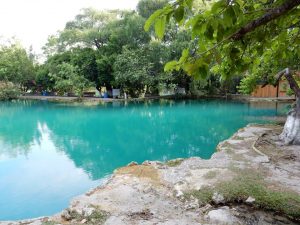 After 10 exciting days in San Cristobal it was time to continue onward through the last part of Mexico to just before the Guatemalan border. From the highlands the road wound its way slowly downward once again into lower lying lands through thick jungle plastered with signs for waterfalls, caves, and ruins – an area with a wealth of attractions, though we didn’t really have any desire to visit them. The three months we spent in Mexico were intensive, with lots of new adventures, unbelievably hospitality and amazing nature experiences. But, it was an extremely tiring three months too. We felt overwhelmed, full to the brim, supersaturated if you will and unable to ingest anything new. We had the feeling that we needed time to allow all that we had experienced to be properly absorbed; and to do that, we really needed a break. Though, with nothing in sight we decided instead to forego doing any sightseeing and headed directly south not really knowing what to do with ourselves. The farther we drove south the more we lost altitude and we soon found ourselves back in the all too familiar hellish heat of the Mexican lowlands – though this time we knew what awaited us, so it wasn’t as bad as it was the first time around. Just before the Guatemalan border we discovered a little paradise – Lagos de Colon – a collection of crystal clear, turquoise blue natural pools (with blessedly cool water!), streams and an Archeological site, which we visited despite being overloaded. The whole thing encompassed a large area and included something like a vacation village. Luckily enough we were arrived during the week so that we were practically the only people there and decided to spend a couple of days to enjoy the park before crossing the border. We made camp at a wonderful campground directly next to a river. Thanks to the cool waters – which we swam in every couple of hours – we were able to withstand the heat quite well. This place must be a mad house on weekends and holidays, though it was almost a ghost town when we were there. Most of the restaurants and shops were closed and we encountered other people only occasionally, giving us the rare chance for quiet reflection and even quieter nights. A wonderful farewell from Mexico.
After 10 exciting days in San Cristobal it was time to continue onward through the last part of Mexico to just before the Guatemalan border. From the highlands the road wound its way slowly downward once again into lower lying lands through thick jungle plastered with signs for waterfalls, caves, and ruins – an area with a wealth of attractions, though we didn’t really have any desire to visit them. The three months we spent in Mexico were intensive, with lots of new adventures, unbelievably hospitality and amazing nature experiences. But, it was an extremely tiring three months too. We felt overwhelmed, full to the brim, supersaturated if you will and unable to ingest anything new. We had the feeling that we needed time to allow all that we had experienced to be properly absorbed; and to do that, we really needed a break. Though, with nothing in sight we decided instead to forego doing any sightseeing and headed directly south not really knowing what to do with ourselves. The farther we drove south the more we lost altitude and we soon found ourselves back in the all too familiar hellish heat of the Mexican lowlands – though this time we knew what awaited us, so it wasn’t as bad as it was the first time around. Just before the Guatemalan border we discovered a little paradise – Lagos de Colon – a collection of crystal clear, turquoise blue natural pools (with blessedly cool water!), streams and an Archeological site, which we visited despite being overloaded. The whole thing encompassed a large area and included something like a vacation village. Luckily enough we were arrived during the week so that we were practically the only people there and decided to spend a couple of days to enjoy the park before crossing the border. We made camp at a wonderful campground directly next to a river. Thanks to the cool waters – which we swam in every couple of hours – we were able to withstand the heat quite well. This place must be a mad house on weekends and holidays, though it was almost a ghost town when we were there. Most of the restaurants and shops were closed and we encountered other people only occasionally, giving us the rare chance for quiet reflection and even quieter nights. A wonderful farewell from Mexico.
However, we noticed something very peculiar here that we hadn’t noticed in other parts of Mexico. The shops, regardless of how small were set up differently. Instead of simply going in and picking out what you wanted you instead waited outside behind locked and barred doors and windows and had to ask for the item you wanted. A very foreign and strange encounter. We asked the locals why and the answer was “Because we are so close to Guatemala”; and the scenario, which we had before the previous border crossings repeated itself: Everyone whom we told we were on our way to Guatemala warned us of how dangerous it is: “Muy peligroso!” (very dangerous) was what almost everyone told us. “Here in Mexico it’s safe but Guatemala…is very dangerous.” By then we had quite a bit of experience with such declarations and were therefore not particularly shocked to hear them; sure we had a bit of a nervous feeling since we had no idea what to expect on the other side of the border, nevertheless one thing was sure as we left the North American continent for Central America and Guatemala – new adventures awaited us!

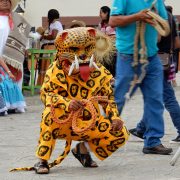
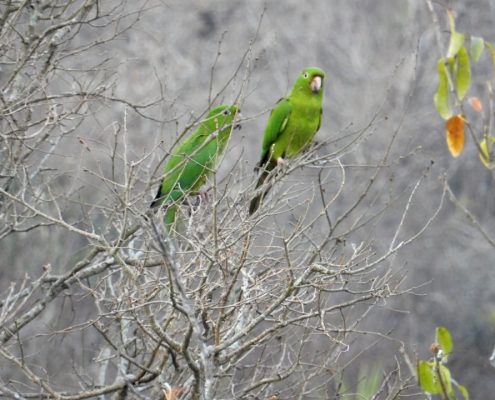
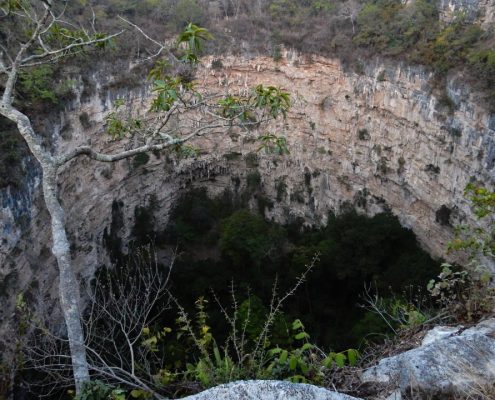
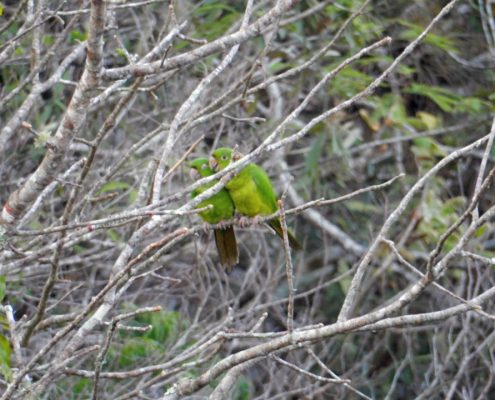
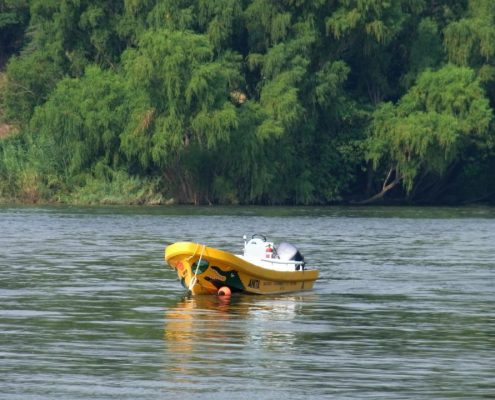
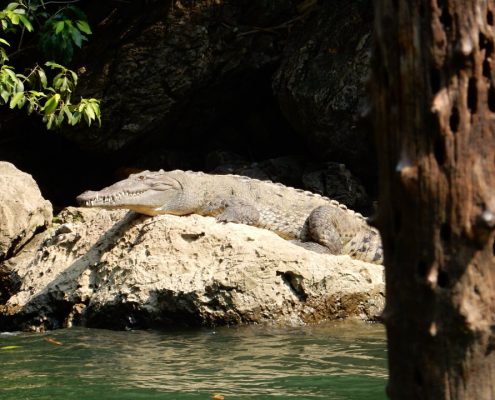
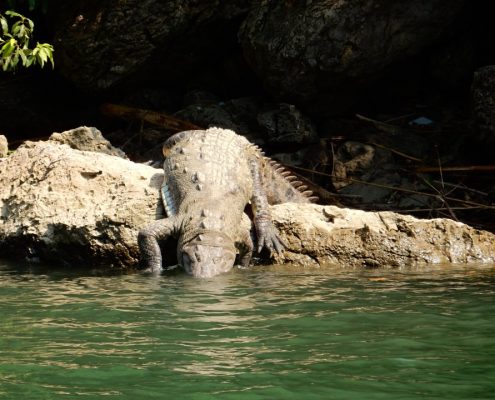
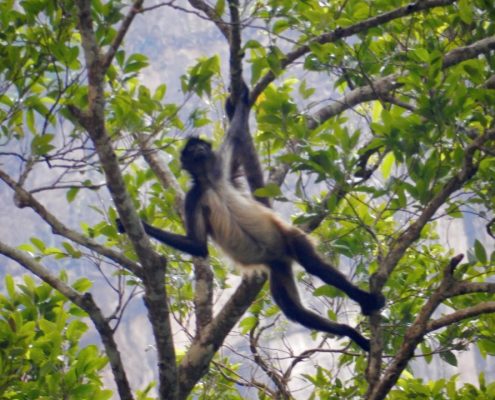
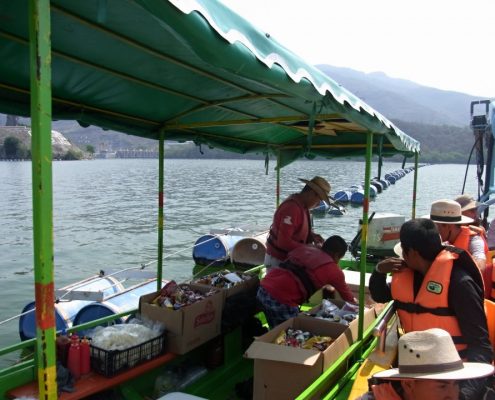
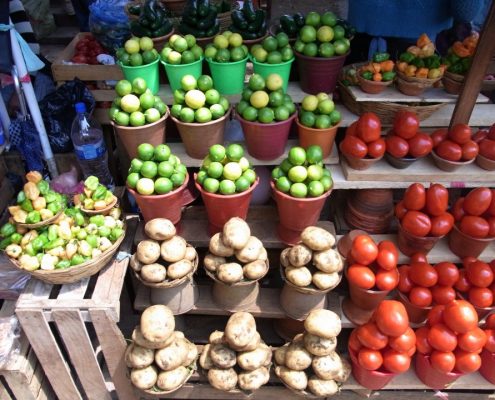
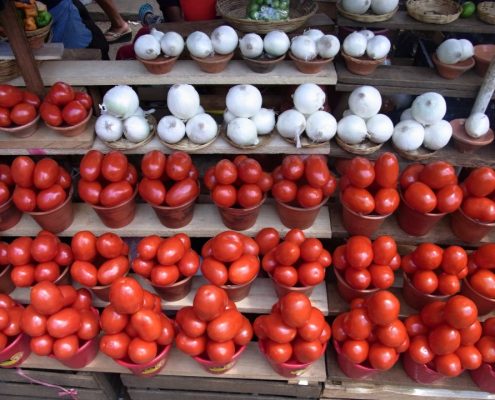
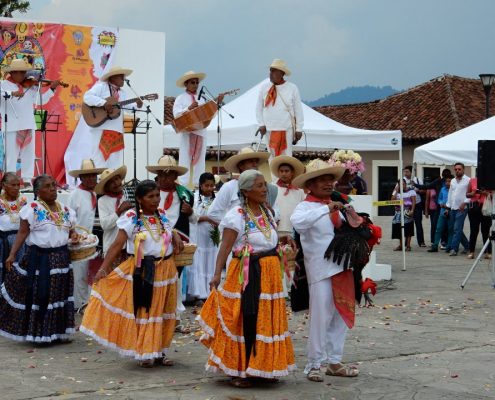
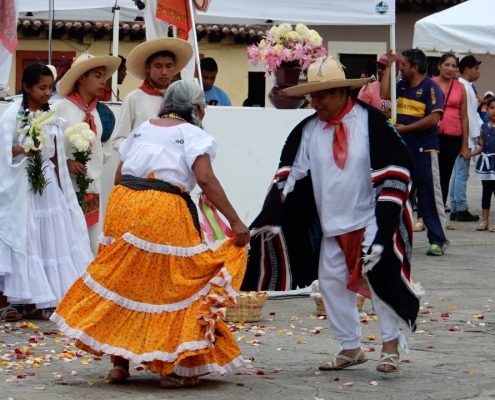
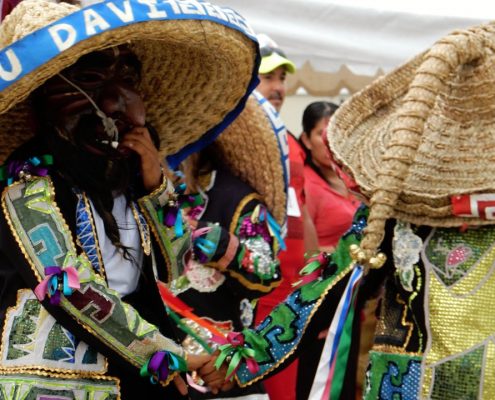
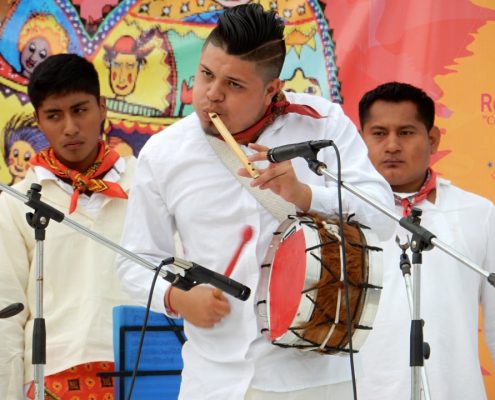
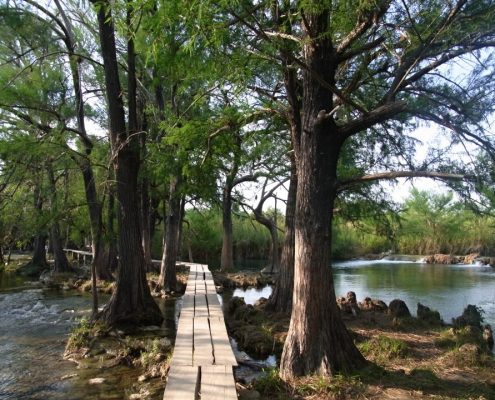
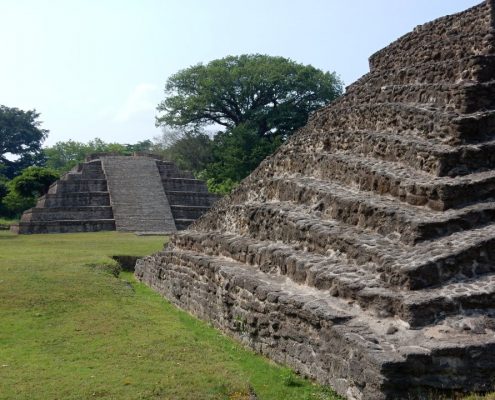
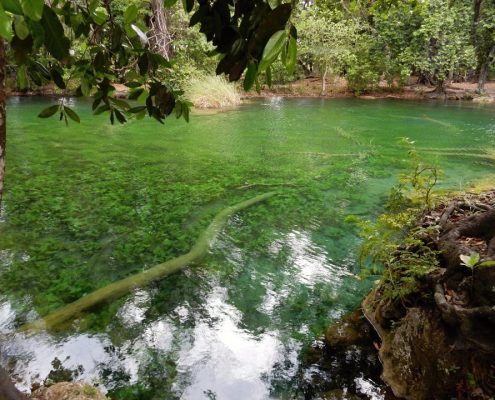
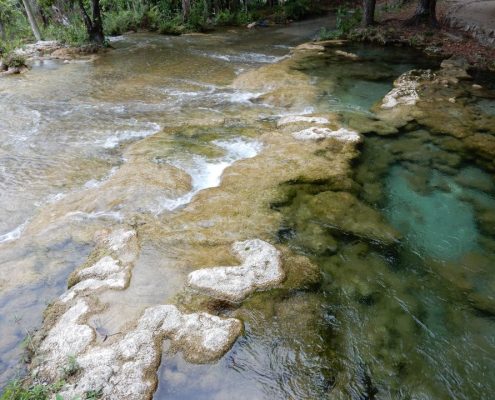
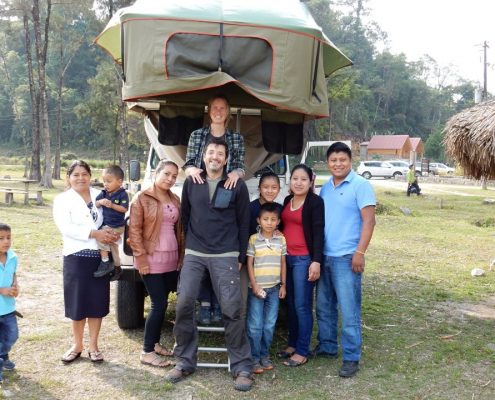


Now I am waiting to hear what happens when you cross the border. Really enjoyed reading this.
Take care.